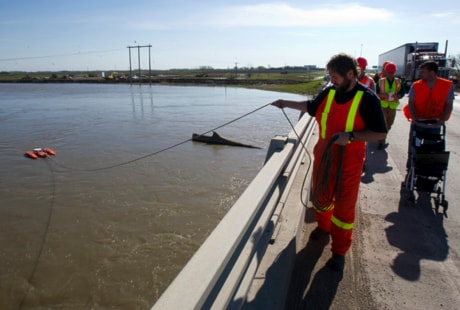WINNIPEG — The Assiniboine River in Manitoba is starting to slowly drop, and while officials warn it will be weeks before things return to normal, they are starting to talk about life after the flood.
The government will announce a compensation package late this week or early next to outline exactly what kind of reimbursement will be given to residents.
Premier Greg Selinger said Tuesday that initial damage estimates are close to $200 million.
The government is even saying that at some point in the near future it might plug a hole in a dike cut last Saturday at an area called the Hoop and Holler bend. The cut was made to ease pressure on the swollen Assiniboine, which had been expected to flood 225 square kilometres of land and affect 150 rural properties.
By Tuesday, the water had covered only 2.7 square kilometres and surrounded, but not flooded, three homes.
“We would certainly hope to cease that operation as soon as it is prudent to do so ... and if we are able to shut it off, that will mean, yes, fewer homes impacted,” said Infrastructure Minister Steve Ashton.
“As soon as it’s safe to do so, we want to be closing off that controlled release.”
The Assiniboine is already starting to recede in western Manitoba. In Brandon, the water was rushing up a little lower on dikes protecting low-lying areas and the city was able to open another route linking the north and south sides of the city. Still, officials warned that it would be the end of the month before water levels will drop enough to allow more than 1,300 people who left the city’s valley to return home.
Further east, the province was predicting the Assiniboine would start to decline near Portage la Prairie and the Hoop and Holler bend by the end of the week, but the drop is expected to be very slow.
The biggest problem appears to lie along the shores of Lake Manitoba, north of Portage la Prairie. Water from a diversion channel and from several swollen rivers has increased the lake level. The lake is expected to remain high for months and any windstorms out of the north could send waves crashing onto hundreds of cottage properties along the southern shore.
“If you look at the lake levels, they are the highest (recorded). It’s uncharted territory,” said Ashton.
Since the flood season began in April, more than 3,600 people have been forced out of their homes across the province. Most of them were moved off aboriginal reserves as a precaution because the water was washing over local roads.
Other people have remained in their homes and have watched their properties be inundated. Now they are wondering what kind of financial aid they’ll be offered.
“It’s going to be six weeks before the water level drops at my place, at least, and everything under water is dead, all the plants and trees,” said Robin Carter, a homeowner who lives less than a kilometre from the government’s deliberate dike-cut at the Hoop and Holler bend.
Carter is worried he won’t be reimbursed for the thousands of dollars he has spent landscaping his property, or for days he missed work to put sandbags around his home — something he said would not have been necessary without the government’s deliberate flood.
The government has talked in broad strokes about offering special compensation to restore land and cover all damages, especially for agricultural producers and businesses. That wording has Carter concerned.
“Most of the properties in my area ... are non-commercial,” he said. If they mean only commercial operations, we will follow through with a lawsuit.“
The premier was unable to say Tuesday whether residential property owners will be fully compensated.
“The final details of that are being worked out,” Selinger said.
“I think the challenge here is ... treat people fairly, and we’ll have to take those kind of things into account.”
